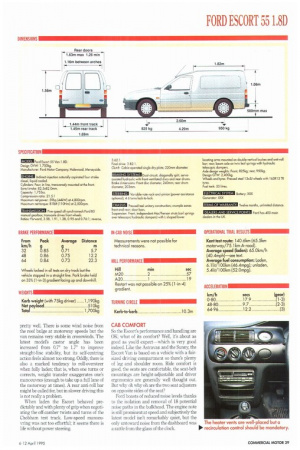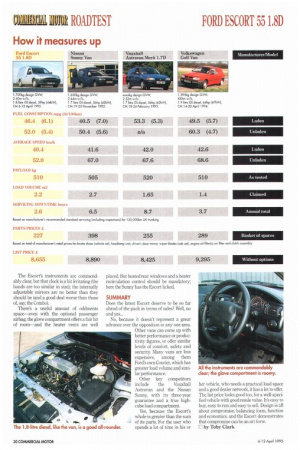ROADTEST
Page 30

Page 31

Page 32

If you've noticed an error in this article please click here to report it so we can fix it.
styling cues from the Mondeo and, in turn, the latest Transit. That ellipse appears again in the shape of the (analogue) clock, the curve of the instrument binnacle and the door trims. What the Escort Van doesn't have is the plastic "wood" trim of the pricier saloons, a throwback to the zebrawood transfers applied to the pressed steel interior of the Ford Model A.
The Escort is certainly well equipped when it comes to passive safety. A driver's-side airbag comes as standard, as do side door impact beams, seat belt grabbers and antisubmarining seat pans (as fitted to the Transit); the passenger-side airbag fitted to our test vehicle is a £230 option.
Other options include power steering (on diesel models only) at £355; electric windows (Q25); heated electric mirrors (£150); and a Quickclear heated windscreen (£130). Ford also offers an upgrade pack for diesel vans: £425 gets you power steering, heated rear windows, cab carpeting, wheel covers and protective mouldings for the body sides.
The Escort has Ford's usual high-security door locks, but only the petrol model can boast an immobiliser as standard; it gets the well-regarded Safeguard system which should also be fitted to diesel models before too long.
PRODUCTIVITY
Ford's 1.8-litre diesel is not the most advanced unit on the market, but in the Escort it provides pretty good fuel consumption. Fully laden, the van returned 46.4mpg (6.11it/100km) round our Kent test route at the fair average speed—bearing in mind appalling traffic and poor weather conditions—of 40.4mph (65.0km/h). Its closest competitor in terms of shape and market perception is probably the Vauxhall Astravan: the last time we tested the 1.7-litre diesel variant of the Vauxhall it returned a rather better 53.3mpg (5.31it/100km), albeit in better conditions.
But the Escort has a couple of points very definitely in its favour: sleek though it is, the Ford has a semi-high-cube shape offering a very respectable 220nf of load volume, mea sured by the realistic VDA method (the more generous SAE measure is 2.54m3). The Astravan can only summon 1.65ne because of its smaller cross-section, which doubtless also contributes to its better fuel economy. Another rival, judging by price and equipment levels, is the Volkswagen Golf Van; this hatchvan also returns excellent fuel consumption figures (60mpg unladen) but offers a mere 1.4m3 of load volume.
The Escort is easy to load, with double rear doors that can be held open at 90° or 180°,
rather than the Vauxhall's tailgate, and a load bed which is just 500mm from the ground when unladen. The ceiling is lower than in a true high-cube, so it is not quite as easy to handle heavy objects at the front of the load space, but overall the load area is more practical than most. It's significantly longer than the Nissan Sunny's, it has some internal lining, there are six (count 'em!) tiedown swivels and a hefty rubber mat. The steel half-height bulkhead is substantial and a mesh upper bulkhead can be specified for an extra £55.
The Escort's payload looks unremarkable, but it's a rather more fair figure than some manufacturers give; loaded up to its full GVW (1,700kg) with a driver in place and weights distributed evenly across the load bed, the Ford's rear axle was supporting just 10kg less than its plated rating of 950kg while the front axle (rated at 825kg) was loaded to 760kg. Certain other car-derived vans seem to need lead weights in the passenger footwell to reach their maximum payload without overloading the rear axle.
Mind you, some weights in the footwell might have been a good idea on our test hills: the front-wheel-drive Escort lacked the traction to negotiate even the 25% (1-in-4) hill, though its handbrake was well able to cope with a 33% (1-in-3).
ON THE ROAD The smooth looks of the Escort promise carlike performance, handling and comfort, but if a vehicle is seriously intended as a load,cariier compromises have to be made.
Let's start with performance: Ford's 1.8 diesel is a bit of an old warhorse which feels rather slow-revving against a paragon of smoothness like the Vauxhall Combo's Isuzu engine. Sure enough, the Escort's 0-80km/h time is almost four seconds adrift of the Combo's, despite similar weights and identical power ratings. But the Vauxhall's engine is unusually flexible and the Ford's acceleration suffers from very tall gearing—it's quite possible to break the national speed limit in third. This does make for relaxed motorway cruising, though the Ford had to drop to fourth to negotiate the M20 hill on our Kent test route. Our low-mileage Escort had a fairly notchy, slow gear change; we'd like to see if that improves with use.
But it would be wrong to imagine that the Ford is underpowered: its measured performance, and the feel of its engine, are remarkably similar to those of the Nissan Sunny which is a good example of the CDV class.
The Escort's aerodynamics seem to work
pretty well. There is some wind noise from the roof bulge at motorway speeds but the van remains very stable in crosswinds. The latest model's castor angle has been increased from 0.7° to 1.7° to improve straight-line stability, but its self-centring action feels almost too strong. Oddly, there is also a marked tendency to roll-oversteer when fully laden; that is, when one turns or corrects, weight transfer exaggerates one's manoeuvres (enough to take up a full lane of the motorway at times). A rear anti-roll bar might be called for, but in slower driving this is not really a problem.
When laden the Escort behaved predictably and with plenty of grip when negotiating the off-camber twists and turns of the Chobham test track. Low-speed manoeuvring was not too effortful; it seems there is life without power steering. CAB COMFORT So the Escort's performance and handling are OK: what of its comfort? Well, it's about as good as you'd expect—which is very good indeed. Like the Astravan and the Sunny, the Escort Van is based on a vehicle with a fairsized driving compartment so there's plenty of leg and shoulder room. Ride comfort is good, the seats are comfortable, the seat-belt mountings are height-adjustable and driver ergonomics are generally well thought out. But why oh why oh are the two seat adjusters on opposite sides of the seat?
Ford boasts of reduced noise levels thanks to the isolation and removal of 18 potential
noise paths in the bulkhead. The engine note is still prominent at speed and subjectively the latest model isn't remarkably quiet, but the only untoward noise from the dashboard was The heater vents are well-placed but a a rattle from the glass of the clock. II, recirculation control should be mandatory.
The Escort's instruments are commendably clear, but that clock is a bit irritating (the hands are too similar in size); the internally adjustable mirrors are no better than they should be (and a good deal worse than those of, say, the Combo).
There's a useful amount of oddments space-even with the optional passenger airbag, the glove compartment offers a fair bit of room-and the heater vents are well placed. But heated rear windows and a heater recirculation control should be mandatory; here the Sunny has the Escort licked.
SUMMARY
Does the latest Escort deserve to be so far ahead of the pack in terms of sales? Well, no and yes...
No, because it doesn't represent a great advance over the opposition in any one area. Other vans can come up with better performance or productivity figures, or offer similar levels of comfort, safety and security. Many vans are less expensive, among them Ford's own Courier, which has greater load volume and similar performance.
Other key competitors include the Vauxhall Astravan and the Nissan Sunny, with its three-year guarantee and a true highcube load compartment.
Yes, because the Escort's whole is greater than the sum of its parts. For the user who spends a lot of time in his or her vehicle, who needs a practical load space and a good dealer network, it has a lot to offer. The list price looks good too, for a well-specified vehicle with good resale value It's easy to buy, easy to run and easy to sell. Design is all about compromise, balancing form, function and economics. and the Escort demonstrates that compromise can be an art form.
E by Toby Clark




























































































